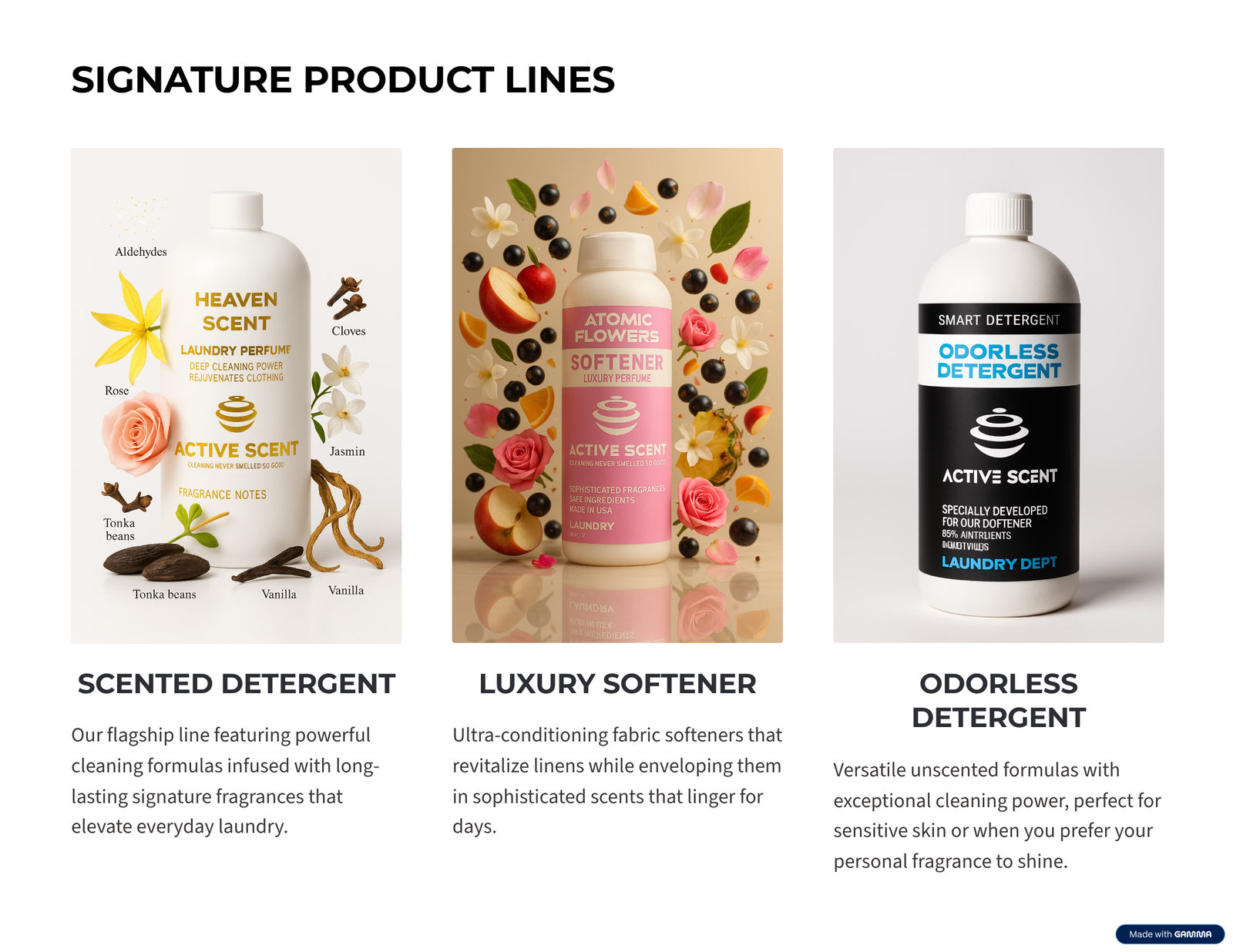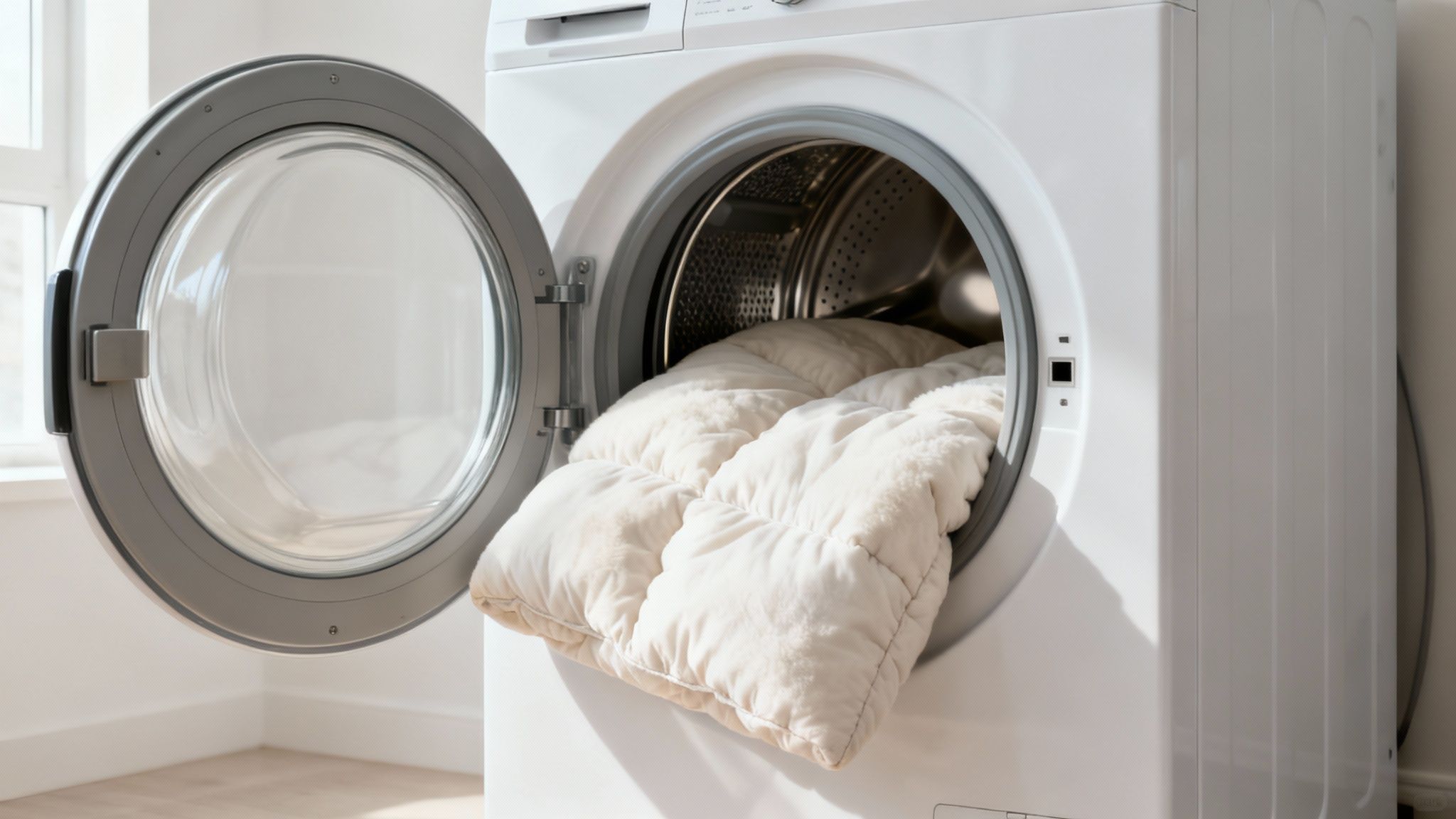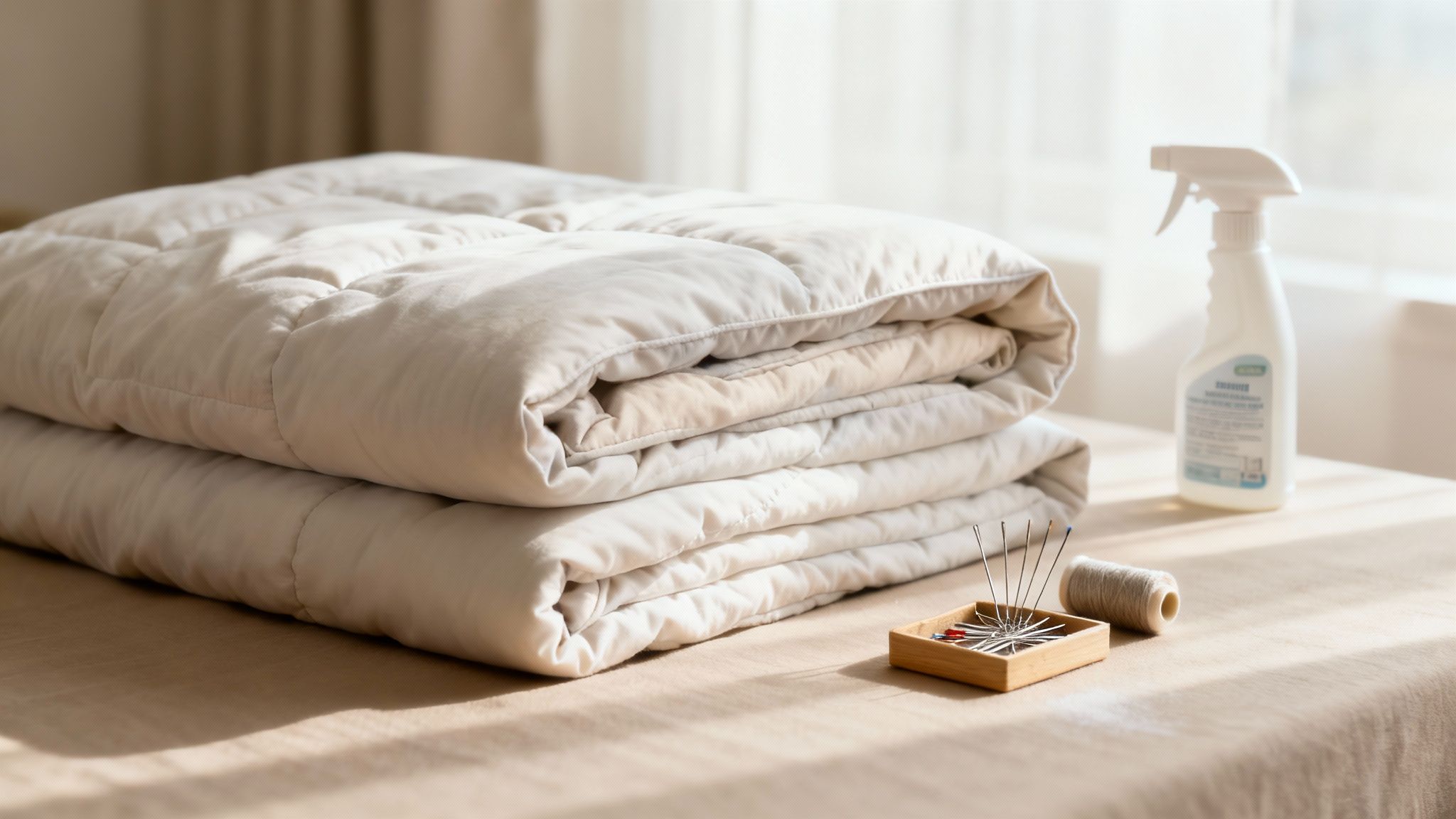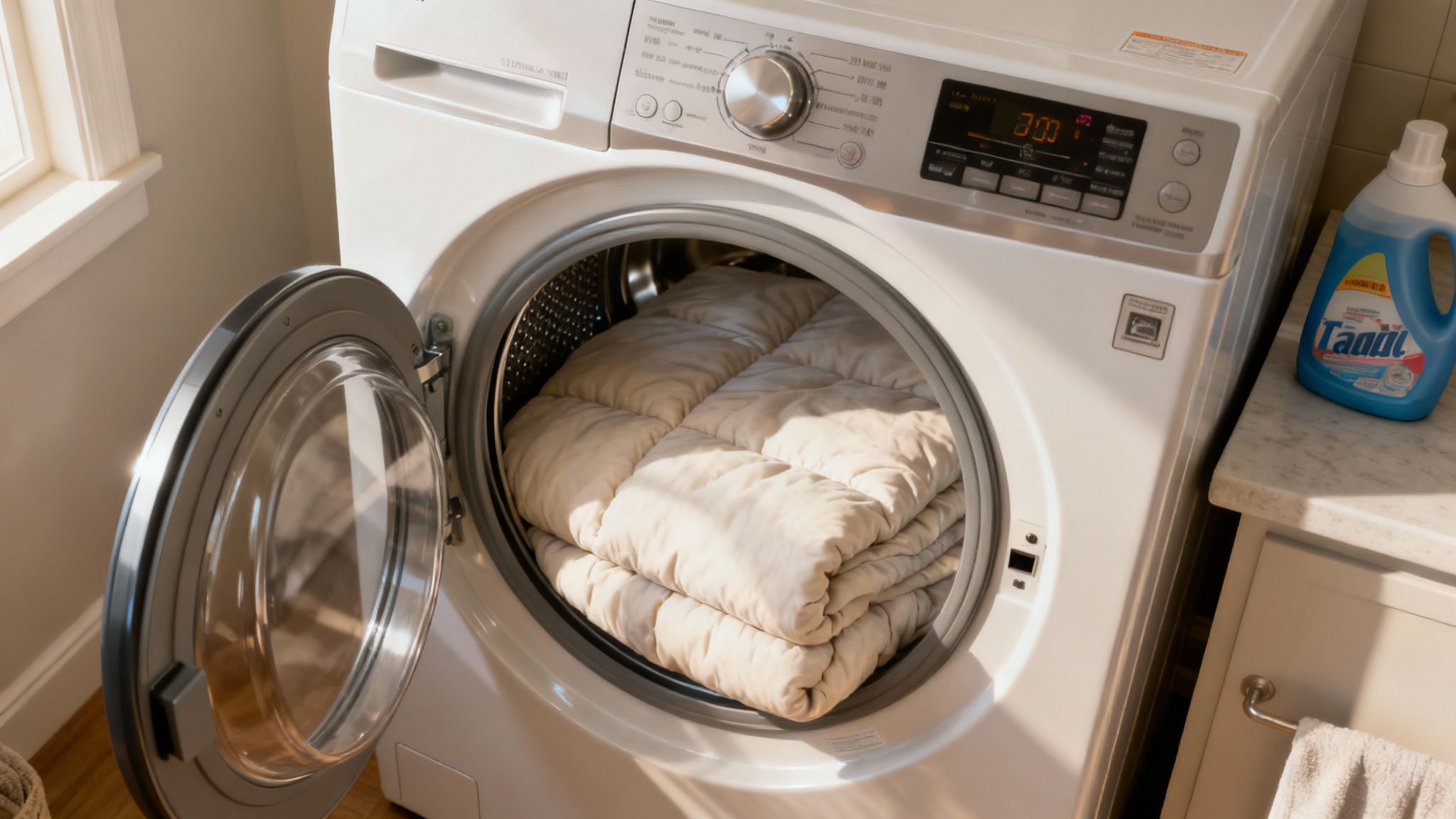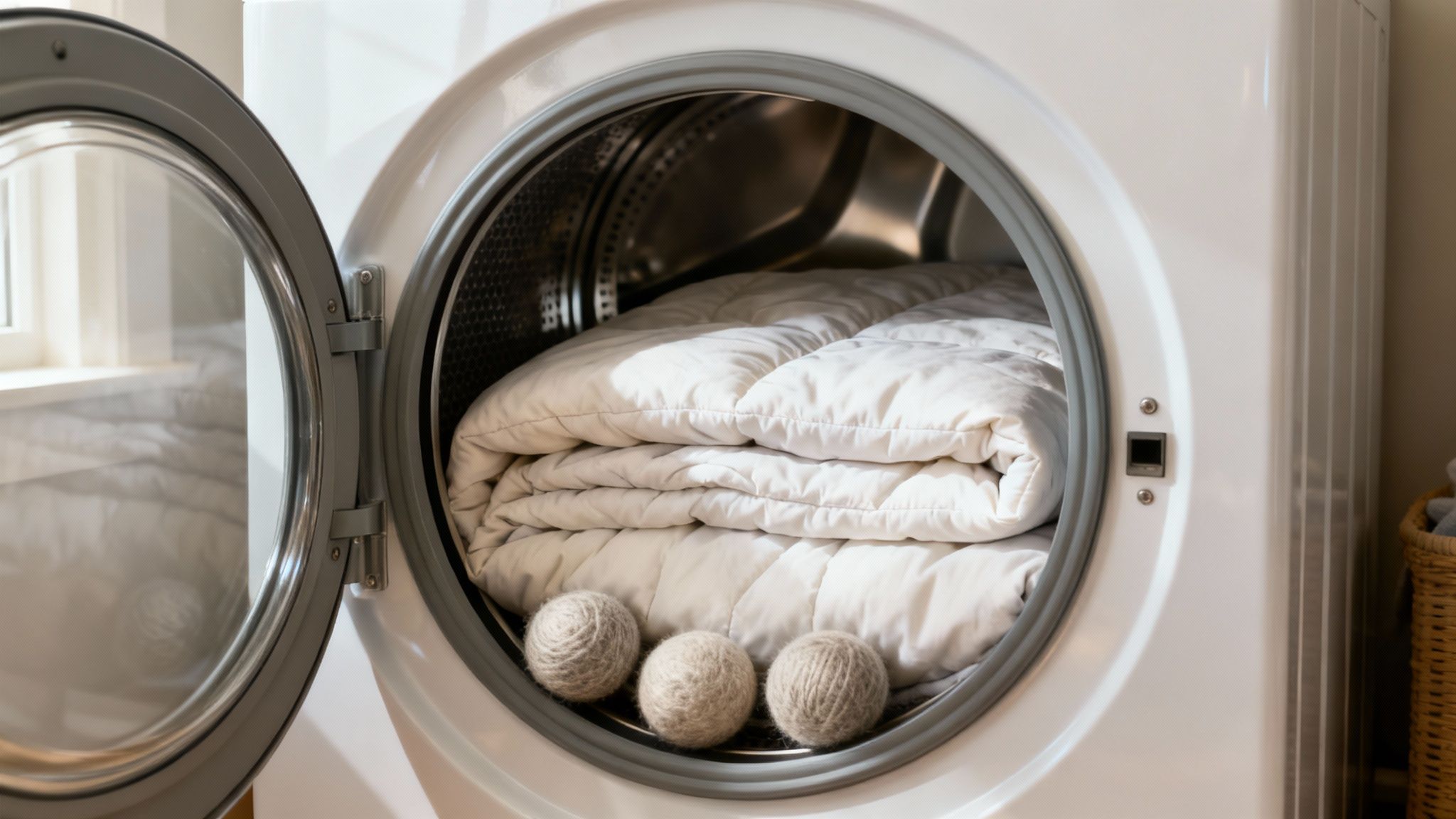
BEST LUXURY LAUNDRY DETERGENT – LONG LASTING SCENTS – (Free Shipping on Orders Over $49)
How to Wash a King Size Comforter and Keep It Fluffy
So, you're ready to tackle that giant king size comforter. The first and most important question to ask yourself is: will it actually fit in my washing machine?
Let’s be real. If you have to shove, jam, or wrestle the comforter into the drum, your machine is too small. It’s that simple. For a truly deep clean, the comforter needs room to move around, letting water and detergent work their magic.
Is Your Washing Machine Up to the Task?
Cramming a bulky comforter into an average-sized washer is a recipe for a laundry fail. You'll end up with an unevenly washed mess, probably with gross, soapy patches still clinging to the fabric. Worse, you could damage your machine's motor or drum, and nobody wants that headache.
Most appliance brands agree on the capacity needed. Maytag suggests at least 4.6 cubic feet, while Whirlpool puts the number at 4.5 cubic feet. This isn't just marketing talk—real-world data shows that 68% of households with large-capacity washers (4.5+ cubic feet) can successfully wash their king comforters. That number plummets to just 22% for those with smaller machines.
The Best Machines for the Job
Not all washers are created equal when it comes to big, bulky items. Your best bets are:
- Front-load machines: These are the champs. Their tumbling action is gentle, and the lack of a central agitator opens up a ton of valuable space.
- High-efficiency (HE) top-load machines: If you have a top-loader, make sure it’s a newer model without that classic tall agitator spindle. These use a low-profile impeller plate at the bottom, which gives you more room and a gentler wash.
Here's a solid rule of thumb I always use: If the dry comforter takes up more than two-thirds of the drum, it’s overcrowded. You have to leave enough space for it to tumble freely once it's saturated with water.
Don't have the specs for your machine handy? Here’s a quick reference guide to see where you stand.
Machine Capacity Guide for King Comforters
Use this quick reference to see if your machine can handle the job or if a laundromat is your best option.
| Machine Capacity (Cubic Feet) | Suitability for King Comforter | Recommendation |
|---|---|---|
| Below 4.0 | Not suitable | Too small. Don't risk it—head to the laundromat. |
| 4.0 – 4.4 | Borderline | Might work for thin/lightweight comforters. Proceed with caution. |
| 4.5 – 5.0 | Good | Ideal for most standard king comforters. |
| 5.0+ | Excellent | The best choice, especially for extra-fluffy or oversized comforters. |
This table should give you a good idea, but nothing beats checking your machine yourself.
The Simple "Hand Test"
If you're still not sure about the cubic footage, just try this simple physical test.
Pop the dry comforter into the drum. You should be able to slide your hand vertically between the top of the comforter and the top of the drum with room to spare. If your hand is squished or you can't fit it in at all, your machine is too small.
It's better to make a trip to the laundromat and use their industrial-sized machines than to end up with a half-washed comforter and a broken washer.
Getting Your Comforter Ready for the Wash
Before you even think about wrestling that king size comforter into the washing machine, a little prep work goes a long way. This isn't just about getting it clean; it's about protecting your investment.
Start by spreading the comforter out on a bed or a clean floor. Give it a good look-over for any small rips, loose threads, or seams that are starting to give way. A tiny hole can easily turn into a disaster in the wash, spilling stuffing everywhere. A few minutes with a needle and thread now will save you from a massive headache later.
First, Treat Any Stains
Now, let's talk stains. Spilled coffee, a smudge of makeup, or a paw print from a furry friend—these need attention before the main event. Spot-treating is non-negotiable if you want them gone for good.
For most common spots, a dab of high-quality, concentrated detergent applied directly to the stain is your best bet. Gently rub the fabric together to work it in, then let it sit for 15-20 minutes. This gives the enzymes time to break down the stain before it ever hits the water.
Never just toss a stained comforter in the wash and hope for the best. The heat from the dryer will permanently set most untreated stains, making them a permanent fixture.
If you're dealing with a musty or mildew odor, a pre-soak might be in order. For those really stubborn smells, you might need a more targeted approach. Our guide on how to clean mildew smell from clothes has some great tips that work just as well for bulky bedding.
Finally, find that little care tag. It's your instruction manual, dictating everything from the right water temperature to the best drying cycle. Following these symbols is the secret to keeping your comforter looking and feeling brand new.
The Washing Method for a Flawless Clean
With your comforter prepped and the machine waiting, it’s time for the main event. Getting a deep, even clean on something this massive is all about balance—both in the machine and in your settings.
First things first, let’s talk loading. Don’t just stuff it in. The trick is to feed the comforter into the drum loosely and evenly, almost like you're coiling a rope. This simple move helps keep the machine balanced during the spin cycle, preventing that violent banging and making sure water and detergent can actually reach every last fiber.
Choosing the Right Cycle and Settings
Once it’s in, selecting the right cycle is everything. You don't want an aggressive setting that could shred the stitching or flatten the filling. Here are the settings that I've found work best for king size comforters:
- The Cycle: Always go for the Bulky/Bedding or Delicate cycle. These use a gentler, slower spin and more water, which is exactly what a heavy, absorbent item needs.
- Water Temp: Stick with cold water. Hot water is a recipe for shrinkage and can be especially harsh on down and down-alternative fillings, causing them to clump.
- Extra Rinse: This isn't optional. An extra rinse cycle is your insurance against that stiff, soapy residue that can make fabric feel scratchy and irritate your skin. For other bulky items like jackets, you can apply similar logic—check out our guide on how to wash down jackets for more tips.
Powerful Cleaning. Zero Interference.
The detergent you choose makes a world of difference. Your goal is a powerful, deep clean that prepares the fabric for a luxurious finish, not an overpowering chemical scent.
This is where a specialized formula comes in. Active Scent's odor-free laundry detergent has been carefully formulated for a deep and effective clean, without competing fragrances. It creates the ultimate neutral base, a perfectly clean canvas designed to complement our range of luxury scented fabric softeners. This approach transforms the wash, leaving your comforter purely clean and ready for a true sensory experience. Explore this unique ritual for yourself with Active Scent.
By creating a perfectly clean and neutral canvas, you're setting the stage for the final step. The goal isn't just to remove dirt but to prepare the fabric for a luxurious, intentionally chosen fragrance infusion, transforming a simple chore into a moment of luxury.
How To Properly Dry Your Comforter
You've made it through the wash cycle, but don't celebrate just yet. The drying phase is where a perfectly clean comforter can turn into a lumpy, damp-smelling mess. Getting this right is the real secret to restoring that cloud-like fluffiness you bought it for.
First rule: always use low heat. It’s tempting to crank it up to get the job done faster, but high temperatures can scorch the fabric. Worse, it makes delicate fillings like down or down-alternatives seize up into dense, uncomfortable balls. Patience is your best friend here. A longer, slower dry is the only way to protect your comforter.
The Secret to Fluffy, Even Drying
For a serious upgrade, toss in a few wool dryer balls. As they bounce around inside the dryer, they get in between the layers of fabric, creating space for warm air to circulate. It’s a simple trick that dramatically speeds up drying time and helps fluff the filling for a far more even result.
But the best technique is a bit more hands-on. You can't just set the timer and forget it.
Pro-Tip: Every 30 minutes, pause the dryer. Pull the comforter out, give it a really good shake to redistribute the filling, and use your hands to break up any clumps that are starting to form. This one little habit is the single most effective way to guarantee a perfectly fluffy, evenly dried comforter.
What If Your Dryer Is Too Small?
If you're battling a standard-sized dryer, don't try to force it. Air-drying is an excellent alternative, but it takes a little strategy.
- Find a spot with good airflow. Drape the comforter over a sturdy drying rack, a clean railing, or even across a few chairs. You want air to hit it from all sides.
- Keep it moving. Every few hours, flip and rotate the comforter so that every part gets its turn to dry.
- Finish with a fluff. Once it feels about 80% dry, you can toss it in your dryer on a low-heat or no-heat "air fluff" setting. Add those dryer balls to finish the job and restore softness. It's a great technique, much like learning how to soften towels naturally without relying on chemical softeners.
Proper drying is about more than just looks. It’s a crucial step in preventing mold in bedding and making sure your favorite comforter lasts for years.
The Finishing Touch: A Signature Scent
With your comforter perfectly dry and impossibly fluffy, this is where the real magic happens. This isn't just about making it clean; it's about transforming it into a sensory experience. LAUNDRY NEVER SMELLED SO GOOD!
This final step transforms your bed into a true sanctuary. We're moving beyond basic freshness and into a world of bold, unforgettable aromas. At Active Scent, our lead perfumer and aroma designer masterfully master light and shadow, creating scents that are as enigmatic as they are energetic.
Infusing Your Bedding With an Unforgettable Aroma
Imagine wrapping yourself in a hypnotic scent crafted with intention. This is the moment laundry becomes an art form. Inspired by the spirit of iconic French houses like Dior, Mugler, Chanel, and Le Labo, our fragrances are bold, mysterious, and unforgettable olfactory statements.
Think deep, earthy patchouli fused with the burning radiance of amber, while fiery pimento berries ignite the composition with spice and warmth. The fragrance is enveloped in the creamy depth of tonka bean and rich guaiac wood, while a touch of styrax adds a smoky elegance. These scents don't just tell a story, they leave a lasting impression.
Choosing a sophisticated fragrance is about more than just washing your bedding. It's a bold tribute to the spirit of renowned fragrance houses, creating a signature experience that makes your personal space feel uniquely yours.
This final touch is what separates a clean comforter from a truly luxurious one. Each product delivers a spark of joy, a touch of boldness, and a surge of confidence. For anyone who appreciates this level of detail, exploring a high-end perfume laundry detergent can completely reinvent how you see this simple household task.
Common Questions About Washing King Comforters
Even with a step-by-step guide, tackling a king size comforter for the first time can bring up a few last-minute questions. Getting the details right is the difference between a perfectly clean, fluffy bed and a laundry-day headache. Let's clear up some of the most common concerns.
First, how often should you really be washing this thing? For most people, a good wash 2-3 times a year is plenty to keep it fresh. But life happens. If you share your bed with furry friends, struggle with allergies, or had an unfortunate coffee spill, you’ll definitely want to wash it more often.
Can I Wash a Down Comforter at Home?
Yes, you absolutely can—but the care label is your final authority. Most down comforters are perfectly happy in a home machine, as long as yours is big enough to give it room to move.
- Stick to the gentle or delicate cycle with cold water. This protects the delicate down clusters from damage.
- Use just a tiny bit of mild, odor-free detergent. Too much soap is hard to rinse out and can leave a residue on the feathers.
- Drying is the most important part. Tumble dry on low heat with a few wool dryer balls to break up clumps and help it regain its loft. Keep it going until it’s 100% dry all the way through to prevent mildew.
That musty smell that sometimes appears after washing is almost always a sign of moisture trapped deep inside. The best fix is to run it through another wash cycle right away, this time adding a cup of white vinegar to the rinse. Then, be meticulous about the drying process until every last bit is completely dry.
For more tips on keeping your comforter in top shape between washes, a good snuggle comforter care guide can offer some great maintenance advice. Following these simple rules will keep your comforter feeling fresh, lofty, and clean for years.
Once your comforter is clean, elevate the experience from simple freshness to pure luxury. At Active Scent, our laundry products are inspired by iconic French fragrance houses, turning an everyday ritual into a moment of indulgence. Discover the collection at https://active-scent.com.

